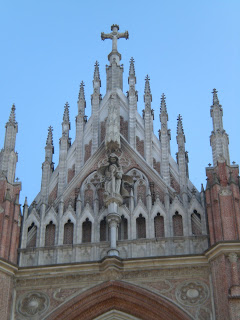Korea town on the other hand is very interesting, mainly, because it's not. It's just a barrio; a regular old neighborhood. It's gray, there are houses, small businesses, churches, etc; but with the main difference that all names, signs and advertisements either contain or are completely written in Korean.
Andre, Jennie and I made it a habit to go there as frequently as we could afford to, since this is one of the few places in Buenos Aires that offers flavorful and well seasoned food. Our main haunt was a small restaurant which both Jennie and Andre were able to point out as characteristically Asian for it's cleanliness and organization. (The most amazing bathroom my eyes ever did behold).

Argentines tend to shy away from everything ethnic (except sushi) to the point where most have never tried Peruvian food, which is the largest immigrant community in the country. So, because of this, Argentines don't do much Chinese food and even less so Korean.
Now, if you've ever had Korean food, you know that it is spicy; that's their signature. This is important because Argentines hate everything spicy. So, every time we went to Korea town we were mostly around Koreans or Peruvians (there is a Peruvian neighborhood right next to Korea Town).

Due to the lack of non-Korean patrons, the restaurant we frequented did not have a Spanish name or menu. They had Chinese and Korean captions, no more. Andre translated the name of the restaurant as 'Happy House', which is what we called it for the rest of our time in BA.

In an interesting turn of events, we began to eat at Happy House regularly (about once every two weeks). We all began to tell and bring our friends (mostly other ex-pats who missed seasoned and flavorful food). They started to tell and bring friends, and so on. Well, it seems the management noticed, because one day we came in and they had a Spanish menu, which meant we could finally find out what the hell we had been eating all this time.

I don't think they know exactly what happened or why all these foreigners had begun to come in so regularly, but they certainly knew who was responsible. They already knew us as regulars. They'd throw a free appetizer our way every now and then, and were always wonderfully attentive. We also brought in the occasional adventurous Argentine who "liked" spicy food, and laughed at their foreseen coughing and request for copious amounts of water due to the unexpected amount of spice in the food.
During my last days in Buenos Aires Jennie and I discovered a new Korean restaurant, this one specializing in Korean BBQ. The place was wonderful, the food was terrific and, though a bit pricier than Happy House, it was well worth the money.

Still, I'm saddened to say that I feel like I betrayed Happy House. After discovering the Korean BBQ place, I never went back to Happy House. As you can see, I don't even remember the other place's name, for my heart lies with Happy House. When Andre and I return to BA, this will certainly be one of our first stops.
Before ending this post, I want to clarify why I've chosen to plug Korea Town and not just Korean food or Happy House. The area is lack luster and fails to be as appealing to tourists as Chinatown, fine. But, the quality of the products is high. Both Andre and Jennie were excited to find many products they remembered and missed from their days in Asia. The bakeries were also good, though I advice you to check the freshness of the pastries. The import stores also carry a lot of pretty and interesting artifacts, which might also be of interest.
Be cautious when visiting Korea town for that near-by Peruvian area is more a slum than a neighborhood. As nice as it is to find good food in a city that hardly knows seasoning, one must be aware that the area is as shaddy as a bible quoting politician; do not trust it.






























































